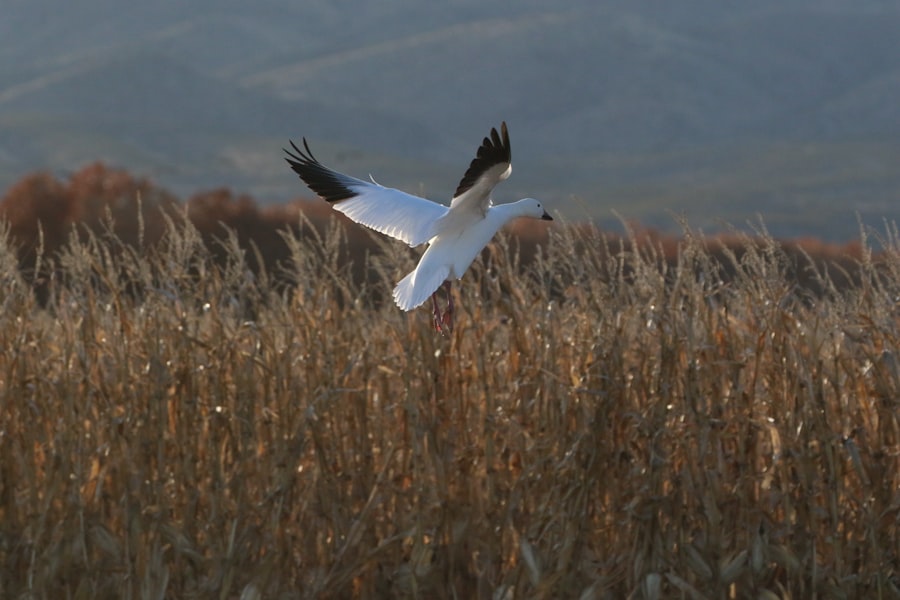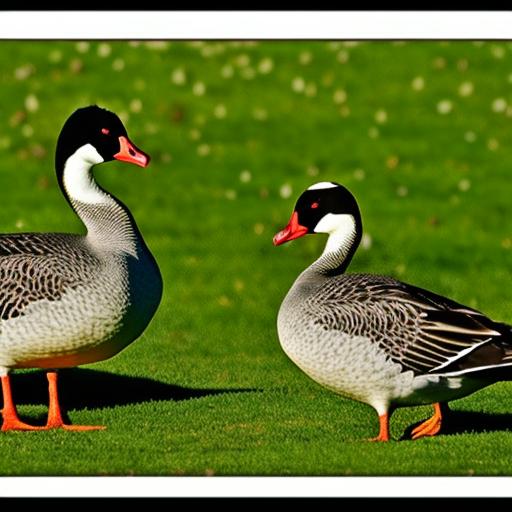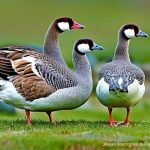Geese can be a beautiful sight in nature, but when they invade our lawns, they can quickly become a nuisance. Their droppings can make a mess of our yards and their constant grazing can damage the grass. It’s important to find effective control methods to keep geese away from our lawns. In this post, we will explore different approaches to geese control, including deterrence, physical barriers, repellents, scare tactics, and more.
Key Takeaways
- Geese are social animals that exhibit territorial behavior and are attracted to open spaces with water and food sources.
- Deterrence is important in preventing geese from establishing a presence on your property, as they can cause damage and pose health risks.
- Physical barriers such as fences and netting can be effective in keeping geese away from certain areas.
- Repellents such as taste aversion sprays and visual deterrents like decoys can also be used to discourage geese from settling in.
- Scare tactics like noise makers and trained dogs can be effective in deterring geese, but must be used consistently to be effective.
Understanding the Behavior of Geese
To effectively control geese, it’s important to understand their behavior. Geese are social animals that often travel in flocks. They are attracted to open spaces with easy access to food and water sources. Lawns provide an ideal grazing area for geese, as they can easily find grass to eat and water sources nearby. Geese also have a strong homing instinct, which means they will return to the same location year after year if they find it suitable.
Understanding these habits and tendencies is crucial in developing effective control methods. By knowing what attracts geese to lawns, we can implement strategies to deter them and make our yards less appealing.
The Importance of Deterrence
Deterrence is a key strategy in keeping geese away from lawns. The goal is to make the area unattractive or uncomfortable for geese, so they choose to go elsewhere. There are different types of deterrence methods that can be used.
Visual deterrents involve using objects or patterns that scare or intimidate geese. This can include things like scarecrows, reflective tape, or predator decoys. Auditory deterrents use sound to scare geese away. This can include devices that emit loud noises or play recordings of predator calls.
The effectiveness of deterrence methods can vary depending on the specific situation and the persistence of the geese. It may be necessary to try different methods or combinations of methods to find what works best for your lawn.
Creating Physical Barriers
Physical barriers can be an effective way to keep geese off of lawns. Fences or netting can be installed to create a physical barrier that prevents geese from accessing the area. The height and design of the barrier will depend on the specific situation and the size of the geese.
One advantage of physical barriers is that they provide a long-term solution. Once installed, they can deter geese from entering the area for an extended period of time. However, they can also be expensive and may not be aesthetically pleasing. It’s important to consider the pros and cons before deciding to install a physical barrier.
Using Repellents
Repellents can be another effective method for keeping geese away from lawns. There are different types of repellents available, including sprays, granules, and liquids. These repellents often contain substances that are unpleasant or irritating to geese, such as capsaicin or methyl anthranilate.
One advantage of repellents is that they can be easily applied to the lawn and are relatively inexpensive. However, they may need to be reapplied regularly, especially after rain or irrigation. It’s also important to choose a repellent that is safe for use around children and pets.
Scare Tactics

Scare tactics can be an effective way to deter geese from lawns. These tactics involve using objects or devices that scare geese away. This can include things like decoys, motion-activated devices, or even trained dogs.
Decoys can be effective because geese are social animals and will avoid areas where they see potential predators. Motion-activated devices can startle geese with sudden movements or loud noises. Trained dogs can also be effective in scaring geese away, as they are natural predators.
One disadvantage of scare tactics is that geese can become habituated to them over time. They may eventually realize that the scare tactics pose no real threat and return to the area. It’s important to regularly change the location or appearance of scare devices to maintain their effectiveness.
Implementing Non-Lethal Control Methods
It’s important to prioritize non-lethal control methods when dealing with geese. Killing or harming geese is not only inhumane, but it can also be illegal in many areas. Non-lethal methods, such as deterrence, physical barriers, repellents, and scare tactics, can effectively control geese without causing harm.
By implementing non-lethal control methods, we can protect our lawns and discourage geese from returning without causing unnecessary harm to these beautiful creatures.
Employing Professional Help
If you’re struggling to control geese on your lawn, it may be worth considering hiring a professional to help. Professionals who specialize in wildlife management or pest control can provide expert advice and assistance in implementing effective geese control methods.
When choosing a professional service provider, it’s important to look for someone with experience in dealing with geese specifically. They should have a good understanding of geese behavior and be knowledgeable about the most effective control methods. It’s also important to ensure that they use non-lethal methods and prioritize the well-being of the geese.
Enhancing the Aesthetics of Your Lawn
Improving the aesthetics of your lawn can also help deter geese. Geese are attracted to open spaces with easy access to food and water sources. By making your lawn less appealing, you can discourage geese from choosing it as a grazing area.
One way to enhance the aesthetics of your lawn is by planting native plants or creating landscaping features that provide visual interest. This can make your lawn less attractive to geese and encourage them to seek out other areas. It’s also important to regularly maintain your lawn by mowing, watering, and fertilizing as needed.
Minimizing Attractants
Minimizing attractants is another important strategy in keeping geese away from lawns. Geese are attracted to areas with easy access to food and water sources. By minimizing these attractants, you can make your lawn less appealing to geese.
One way to minimize attractants is by removing or securing potential food sources. This can include things like fallen fruit, bird feeders, or open garbage cans. It’s also important to minimize water sources, such as ponds or birdbaths, that may attract geese.
Consistency and Persistence in Maintenance
Consistency and persistence are key in maintaining geese control methods. Geese can be persistent creatures and may continue to test the effectiveness of your control methods. It’s important to regularly monitor and maintain your chosen methods to ensure their continued effectiveness.
Regularly inspect physical barriers for any damage or gaps that may allow geese to enter. Reapply repellents as needed, especially after rain or irrigation. Move scare devices regularly to prevent geese from becoming habituated. By staying consistent and persistent in your maintenance efforts, you can effectively keep geese away from your lawn.
Geese can be a nuisance on lawns, but with the right control methods, we can effectively deter them and protect our yards. By understanding the behavior of geese and implementing strategies such as deterrence, physical barriers, repellents, scare tactics, and more, we can create an environment that is unattractive or uncomfortable for geese.
It’s important to prioritize non-lethal control methods and consider hiring a professional if needed. Enhancing the aesthetics of our lawns, minimizing attractants, and staying consistent and persistent in maintenance efforts can also help in keeping geese away.
Remember that every situation is unique, and it may take some trial and error to find what works best for your lawn. By trying different methods and staying proactive, you can successfully control geese and enjoy a beautiful, goose-free lawn.
If you’re looking for effective ways to keep geese off your lawn, you might also be interested in learning about the benefits of having a chicken coop trampoline. This innovative solution, as discussed in the article “Chicken Coop Trampoline” on PoultryWizard.com, not only provides a fun and engaging environment for your chickens but also helps protect your lawn from unwanted visitors like geese. By incorporating this unique feature into your chicken coop, you can create a safe and enjoyable space for your feathered friends while keeping geese at bay.
FAQs
What are some common problems caused by geese on lawns?
Geese can cause damage to lawns by eating grass, leaving droppings, and creating holes in the ground. They can also be aggressive towards humans and pets.
What are some methods for keeping geese off lawns?
Some effective methods for keeping geese off lawns include using decoys, installing fencing or netting, using noise deterrents, and applying repellents.
What are some natural repellents for geese?
Some natural repellents for geese include planting certain types of vegetation, such as tall grasses or shrubs, and using essential oils, such as peppermint or citrus.
Are there any humane methods for keeping geese off lawns?
Yes, there are several humane methods for keeping geese off lawns, such as using noise deterrents or installing fencing or netting. It is important to avoid harming the geese or their habitat.
What should I do if I encounter aggressive geese on my lawn?
If you encounter aggressive geese on your lawn, it is important to stay calm and avoid provoking them. Slowly back away and give them plenty of space. If necessary, seek assistance from a professional wildlife control service.
Meet Walter, the feathered-friend fanatic of Florida! Nestled in the sunshine state, Walter struts through life with his feathered companions, clucking his way to happiness. With a coop that’s fancier than a five-star hotel, he’s the Don Juan of the chicken world. When he’s not teaching his hens to do the cha-cha, you’ll find him in a heated debate with his prized rooster, Sir Clucks-a-Lot. Walter’s poultry passion is no yolk; he’s the sunny-side-up guy you never knew you needed in your flock of friends!







